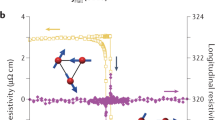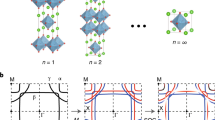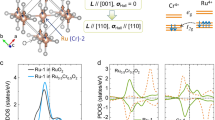Abstract
The anomalous Hall effect is a time-reversal symmetry-breaking magneto-electronic phenomenon originally discovered in ferromagnets. Recently, ruthenium dioxide (RuO2) with a compensated antiparallel magnetic order has been predicted to generate an anomalous Hall effect of comparable strength to ferromagnets. The phenomenon arises from an altermagnetic phase of RuO2 with a characteristic alternating spin polarization in both real-space crystal structure and momentum-space band structure. Here we report an anomalous Hall effect in RuO2 with an anomalous Hall conductivity exceeding 1,000 Ω−1 cm−1. We combine the vector magnetometry and magneto-transport measurements of epitaxial RuO2 films of different crystallographic orientations. We show that the anomalous Hall effect dominates over an ordinary Hall contribution, and a contribution due to a weak field-induced magnetization. Our results could lead to the exploration of topological Berry phases and dissipationless quantum transport in crystals of abundant elements and with a compensated antiparallel magnetic order.
This is a preview of subscription content, access via your institution
Access options
Access Nature and 54 other Nature Portfolio journals
Get Nature+, our best-value online-access subscription
$29.99 / 30 days
cancel any time
Subscribe to this journal
Receive 12 digital issues and online access to articles
$119.00 per year
only $9.92 per issue
Buy this article
- Purchase on Springer Link
- Instant access to full article PDF
Prices may be subject to local taxes which are calculated during checkout




Similar content being viewed by others
Data availability
The data that support the plots within this paper and other findings of this study are available from the corresponding author upon reasonable request.
Change history
29 November 2022
A Correction to this paper has been published: https://doi.org/10.1038/s41928-022-00907-7
References
Nagaosa, N., Sinova, J., Onoda, S., MacDonald, A. H. & Ong, N. P. Anomalous Hall effect. Rev. Mod. Phys. 82, 1539–1592 (2010).
Chappert, C., Fert, A. & Van Dau, F. N. The emergence of spin electronics in data storage. Nat. Mater. 6, 813–823 (2007).
Néel, L. Some new results on antiferromagnetism and ferromagnetism. Rev. Mod. Phys. 25, 58–63 (1953).
Néel, L. Magnetism and local molecular field. Science 174, 985–992 (1971).
Kurti, N. Selected Works of Louis Néel 1st edn (CRC Press, 1988).
Šmejkal, L., MacDonald, A. H., Sinova, J., Nakatsuji, S. & Jungwirth, T. Anomalous Hall antiferromagnets. Nat. Rev. Mater. 7, 482–496 (2022).
Šmejkal, L., Železný, J., Sinova, J. & Jungwirth, T. Electric control of Dirac quasiparticles by spin-orbit torque in an antiferromagnet. Phys. Rev. Lett. 118, 106402 (2017).
Shindou, R. & Nagaosa, N. Orbital ferromagnetism and anomalous Hall effect in antiferromagnets on the distorted fcc lattice. Phys. Rev. Lett. 87, 116801 (2001).
Machida, Y., Nakatsuji, S., Onoda, S., Tayama, T. & Sakakibara, T. Time-reversal symmetry breaking and spontaneous Hall effect without magnetic dipole order. Nature 463, 210–213 (2010).
Chen, H., Niu, Q. & Macdonald, A. H. Anomalous Hall effect arising from noncollinear antiferromagnetism. Phys. Rev. Lett. 112, 017205 (2014).
Kübler, J. & Felser, C. Non-collinear antiferromagnets and the anomalous Hall effect. EPL 108, 67001 (2014).
Nakatsuji, S., Kiyohara, N. & Higo, T. Large anomalous Hall effect in a non-collinear antiferromagnet at room temperature. Nature 527, 212–215 (2015).
Nayak, A. K. et al. Large anomalous Hall effect driven by a nonvanishing Berry curvature in the noncolinear antiferromagnet Mn3Ge. Sci. Adv. 2, e1501870 (2016).
Liu, Z. Q. et al. Electrical switching of the topological anomalous Hall effect in a non-collinear antiferromagnet above room temperature. Nat. Electron. 1, 172–177 (2018).
Šmejkal, L., González-Hernández, R., Jungwirth, T. & Sinova, J. Crystal time-reversal symmetry breaking and spontaneous Hall effect in collinear antiferromagnets. Sci. Adv. 6, eaaz8809 (2020).
Berlijn, T. et al. Itinerant antiferromagnetism in RuO2. Phys. Rev. Lett. 118, 077201 (2017).
Zhu, Z. H. et al. Anomalous antiferromagnetism in metallic RuO2 determined by resonant X-ray scattering. Phys. Rev. Lett. 122, 017202 (2019).
González-Hernández, R. et al. Efficient electrical spin splitter based on nonrelativistic collinear antiferromagnetism. Phys. Rev. Lett. 126, 127701 (2021).
Bose, A. et al. Tilted spin current generated by the collinear antiferromagnet RuO2. Nat. Electron. 5, 267–274 (2022).
Bai, H. et al. Observation of spin splitting torque in a collinear antiferromagnet RuO2. Phys. Rev. Lett. 128, 197202 (2022).
Karube, S. et al. Observation of spin-splitter torque in collinear antiferromagnetic RuO2. Phys. Rev. Lett. 129, 137201 (2022).
Šmejkal, L. et al. Giant and tunneling magnetoresistance in unconventional collinear antiferromagnets with nonrelativistic spin-momentum coupling. Phys. Rev. X 12, 011028 (2022).
Shao, D.-F., Zhang, S.-H., Li, M., Eom, C.-B. & Tsymbal, E. Y. Spin-neutral currents for spintronics. Nat. Commun. 12, 7061 (2021).
Ahn, K.-H. et al. Antiferromagnetism in RuO2 as d-wave Pomeranchuk instability. Phys. Rev. B 99, 184432 (2019).
Hayami, S., Yanagi, Y. & Kusunose, H. Momentum-dependent spin splitting by collinear antiferromagnetic ordering. J. Phys. Soc. Jpn 88, 123702 (2019).
Šmejkal, L., Sinova, J. & Jungwirth, T. Beyond conventional ferromagnetism and antiferromagnetism: a phase with nonrelativistic spin and crystal rotation symmetry. Phys. Rev. X 12, 031042 (2022).
Šmejkal, L., Sinova, J. & Jungwirth, T. Emerging research landscape of altermagnetism. Phys. Rev. X (in the press).
Yuan, L.-D., Wang, Z., Luo, J.-W., Rashba, E. I. & Zunger, A. Giant momentum-dependent spin splitting in centrosymmetric low-Z antiferromagnets. Phys. Rev. B 102, 014422 (2020).
Yuan, L.-D., Wang, Z., Luo, J.-W. & Zunger, A. Prediction of low-Z collinear and non-collinear antiferromagnetic compounds having momentum-dependent spin splitting even without spin-orbit coupling. Phys. Rev. Mater. 5, 014409 (2021).
Bazhan, A. N. & Bazan, C. Weak ferromagnetism in CoF2 and NiF2. Sov. Phys. JETP 42, 898–904 (1976).
Landau, L. & Lifshitz, E. Electrodynamics of Continuous Media, Vol. 8 of Course of Theoretical Physics 2nd edn (Pergamon Press, 1965).
Ryden, W., Lawson, A. & Sartain, C. Temperature dependence of the resistivity of RuO2 and IrO2. Phys. Lett. A 26, 209–210 (1968).
Weischenberg, J., Freimuth, F., Sinova, J., Blügel, S. & Mokrousov, Y. Ab initio theory of the scattering-independent anomalous Hall effect. Phys. Rev. Lett. 107, 106601 (2011).
Samanta, K. et al. Crystal Hall and crystal magneto-optical effect in thin films of SrRuO3. J. Appl. Phys. 127, 213904 (2020).
Hayami, S., Yanagi, Y. & Kusunose, H. Bottom-up design of spin-split and reshaped electronic band structures in antiferromagnets without spin-orbit coupling: procedure on the basis of augmented multipoles. Phys. Rev. B 102, 144441 (2020).
Reichlova, H. et al. Macroscopic time reversal symmetry breaking arising from antiferromagnetic Zeeman effect. Preprint at https://arxiv.org/abs/2012.15651 (2020).
Egorov, S. A. & Evarestov, R. A. Colossal spin splitting in the monolayer of the collinear antiferromagnet MnF2. J. Phys. Chem. Lett. 12, 2363–2369 (2021).
Shao, D. F., Ding, J., Gurung, G., Zhang, S. H. & Tsymbal, E. Y. Interfacial crystal Hall effect reversible by ferroelectric polarization. Phys. Rev. Appl. 15, 024057 (2021).
Naka, M. et al. Spin current generation in organic antiferromagnets. Nat. Commun. 10, 4305 (2019).
Naka, M. et al. Anomalous Hall effect in κ-type organic antiferromagnets. Phys. Rev. B 102, 075112 (2020).
Mazin, I. I., Koepernik, K., Johannes, M. D., González-Hernández, R. & Šmejkal, L. Prediction of unconventional magnetism in doped FeSb2. Proc. Natl. Acad. Sci. U. S. A. 118, e2108924118 (2021).
Šmejkal, L., Mokrousov, Y., Yan, B. & MacDonald, A. H. Topological antiferromagnetic spintronics. Nat. Phys. 14, 242–251 (2018).
Tokura, Y., Yasuda, K. & Tsukazaki, A. Magnetic topological insulators. Nat. Rev. Phys. 1, 126–143 (2019).
Blöchl, P. E. Projector augmented-wave method. Phys. Rev. B 50, 17953–17979 (1994).
Dudarev, S. L., Botton, G. A., Savrasov, S. Y., Humphreys, C. J. & Sutton, A. P. Electron-energy-loss spectra and the structural stability of nickel oxide: an LSDA+U study. Phys. Rev. B 57, 1505–1509 (1998).
Perdew, J. P., Burke, K. & Ernzerhof, M. Generalized gradient approximation made simple. Phys. Rev. Lett. 77, 3865–3868 (1996).
Mostofi, A. A. et al. wannier90: a tool for obtaining maximally-localised Wannier functions. Comput. Phys. Commun. 178, 685–699 (2008).
Liang, Q. et al. Anti-ferromagnetic RuO2: a stable and robust OER catalyst over a large range of surface terminations. J. Phys. Chem. C 126, 1337–1345 (2022).
Acknowledgements
We thank J. M. D. Coey at Trinity College, Dublin, and C. Jiang at Beihang University for enlightening and helpful discussion during the preparation of the relevant early versions of this manuscript. Z.L. acknowledges financial support from the National Natural Science Foundation of China (NSFC; grant nos. 52271235 and 52121001). Z.L. and Z.Z. acknowledge financial support from the NSFC on the Science Foundation Ireland (SFI)–NSFC Partnership Programme (NSFC grant no. 51861135104). L.Š., J.S. and T.J. were supported in part by the Ministry of Education of the Czech Republic Grants LM2018110 and LNSM-LNSpin, by the Grant Agency of the Czech Republic grant no. 19-28375X and by the EU FET Open RIA grant no. 766566. L.Š. and R.G.-H. acknowledge the use of the supercomputer Mogon at Johannes Gutenberg Universität (https://hpc.uni-mainz.de/), the computing and storage facilities owned by parties and projects contributing to the National Grid Infrastructure MetaCentrum provided under the programme Projects of Large Research, Development, and Innovations Infrastructures (CESNET LM2015042). L.Š. and J.S. acknowledge support from the Alexander von Humboldt Foundation and the Deutsche Forschungsgemeinschaft (DFG, German Research Foundation)—TRR 173-268565370 (project A03).
Author information
Authors and Affiliations
Contributions
Z.F. and X.Zhou performed the sample growth, electrical, structural and magnetic measurements with assistance from L.W., Z.Z., H.G., X.W., H.Y., P.Q., X.Zhang, H.W., H.C., Z.M., L.L. and Z.X. The theoretical calculations were performed by L.Š., R.G.-H., J.S. and T.J. Data analysis was conducted by Z.L., Z.F., X.Zhou, L.Š., R.G.-H., J.S. and T.J. The manuscript was written by Z.L., Z.F., X. Zhou, L.Š., J.S. and T.J. All the authors commented on manuscript. This project was conceived and led by Z.L.
Corresponding author
Ethics declarations
Competing interests
The authors declare no competing interests.
Peer review
Peer review information
Nature Electronics thanks Hanno Weitering and the other, anonymous, reviewer(s) for their contribution to the peer review of this work.
Additional information
Publisher’s note Springer Nature remains neutral with regard to jurisdictional claims in published maps and institutional affiliations.
Extended data
Extended Data Fig. 1 Supporting DFT calculations.
a, Strongly momentum-dependent spin-split Fermi surface calculated without spin-orbit interaction and with Hubbard U = 1.6 eV. b, Strong crystal-momentum resolved Berry curvature in RuO2 calculated with spin-orbit interaction included and magnetic moments along [110] corresponding to the intrinsic anomalous Hall conductivity vector along [110]. The black contours mark Fermi surface. c, Anomalous Hall conductivity vs. energy calculated for the Néel vector along [110] crystal axis. Zero energy corresponds to the Fermi level position in stoichiometric RuO2. d, Magnetocrystalline anisotropy energy (MAE) E[110]-E[001] vs. energy. e, Anomalous Hall conductivity dependence on Hubbard U. f, Corresponding dependence of the magnitude of the sublattice magnetic moment Hubbard U.
Extended Data Fig. 2 Conductivity phase diagram of RuO2 thin films.
Conductivity phase diagram of RuO2 thin films fabricated on MgO substrates versus the deposition oxygen partial pressure and the substrate temperature. Each data point represents the mean conductivity value derived from the measurements of three repeating samples.
Extended Data Fig. 3 Exchange bias experiments.
The exchange bias measurements were performed after field cooling from 400 K by a + 500 mT field applied in plane. a. Coercivity fields of a Pt(2 nm)/CoFe(5 nm)/RuO2(27 nm)/TiO2(110) sample and a Pt(2 nm)/CoFe(5 nm)/TiO2(110) sample as a function of temperature. b. Normalized magnetization of the Pt(2 nm)/CoFe(5 nm)/RuO2(27 nm)/TiO2(110) sample at 50 K. c. Exchange bias field of the CoFe/RuO2 system versus temperature. d. Normalized magnetization of the post-annealed Pt(2 nm)/CoFe(5 nm)/RuO2(27 nm)/TiO2(110) sample at 200 K. e. Exchange bias field of the post-annealed sample as a function of temperature. The sample was annealed at 250 °C for 1 h in a vacuum furnace under an in-plane magnetic field of 500 mT.
Extended Data Fig. 4 Structural characterization of a RuO2/TiO2(100) heterostructure.
a. X-ray diffraction data. b. Cross-section transmission electron microscopy image of the RuO2 film.
Extended Data Fig. 5 Structural characterization of a RuO2/TiO2(001) heterostructure.
a. X-ray diffraction data. b. Cross-section transmission electron microscopy image of the RuO2 film.
Extended Data Fig. 6 Structure and exchange bias of a (110)-oriented RuO2/MgO thin film.
a, X-ray diffraction spectrum. Inset: Schematic of the RuO2/MgO heterostructure. b, Normalized in-plane magnetization of the Pt/CoFe/RuO2/MgO stack as a function of magnetic field at 50 K. c, Comparison of the in-plane coercivity field of Co90Fe10 (CoFe) films in a Pt/CoFe/RuO2/MgO heterostructure and a Pt/CoFe/MgO heterostructure. Inset: Schematic of a RuO2/MgO heterostructure capped by a 5-nm-thick CoFe layer and a 2-nm-thick Pt top layer. d, In-plane exchange bias field of the Pt/CoFe/RuO2/MgO heterostructure versus temperature.
Extended Data Fig. 7 X-ray diffraction of a RuO2/SrTiO3(001) heterostructure.
X-ray diffraction of a RuO2/SrTiO3(001) heterostructure.
Extended Data Fig. 8 Electrical transport of the (100)-oriented RuO2/SrTiO3 and the (110)-oriented RuO2/MgO sample.
a. Temperature-dependent resistivity. b. Hall resistivity as a function of pulsed magnetic fields for the (110)-oriented RuO2/MgO sample. c. Hall resistivity as a function of pulsed magnetic fields for the (100)-oriented RuO2/SrTiO3 sample.
Extended Data Fig. 9 High-field moments of substrates and substrates plus films.
High-field moments of substrates and substrates plus films.
Extended Data Fig. 10 Supporting DFT calculations in magnetic field.
a, Band structure calculated with moments along [110] crystal direction and without/with applied magnetic field along [110] direction implemented via a Zeeman term in the ELK code. b, Momentum resolved Berry curvature calculated in Wannier90 from the bands obtained in VASP code in zero magnetic field.
Rights and permissions
Springer Nature or its licensor (e.g. a society or other partner) holds exclusive rights to this article under a publishing agreement with the author(s) or other rightsholder(s); author self-archiving of the accepted manuscript version of this article is solely governed by the terms of such publishing agreement and applicable law.
About this article
Cite this article
Feng, Z., Zhou, X., Šmejkal, L. et al. An anomalous Hall effect in altermagnetic ruthenium dioxide. Nat Electron 5, 735–743 (2022). https://doi.org/10.1038/s41928-022-00866-z
Received:
Accepted:
Published:
Issue Date:
DOI: https://doi.org/10.1038/s41928-022-00866-z
This article is cited by
-
Room-temperature flexible manipulation of the quantum-metric structure in a topological chiral antiferromagnet
Nature Physics (2024)
-
Large anomalous Hall effect in spin fluctuating devil’s staircase
npj Quantum Materials (2024)
-
New type of magnetism splits from convention
Nature (2024)
-
Finite-momentum Cooper pairing in proximitized altermagnets
Nature Communications (2024)
-
Direct observation of altermagnetic band splitting in CrSb thin films
Nature Communications (2024)



